check engine light CHRYSLER CONCORDE 2004 2.G Owners Manual
[x] Cancel search | Manufacturer: CHRYSLER, Model Year: 2004, Model line: CONCORDE, Model: CHRYSLER CONCORDE 2004 2.GPages: 273, PDF Size: 6 MB
Page 9 of 273
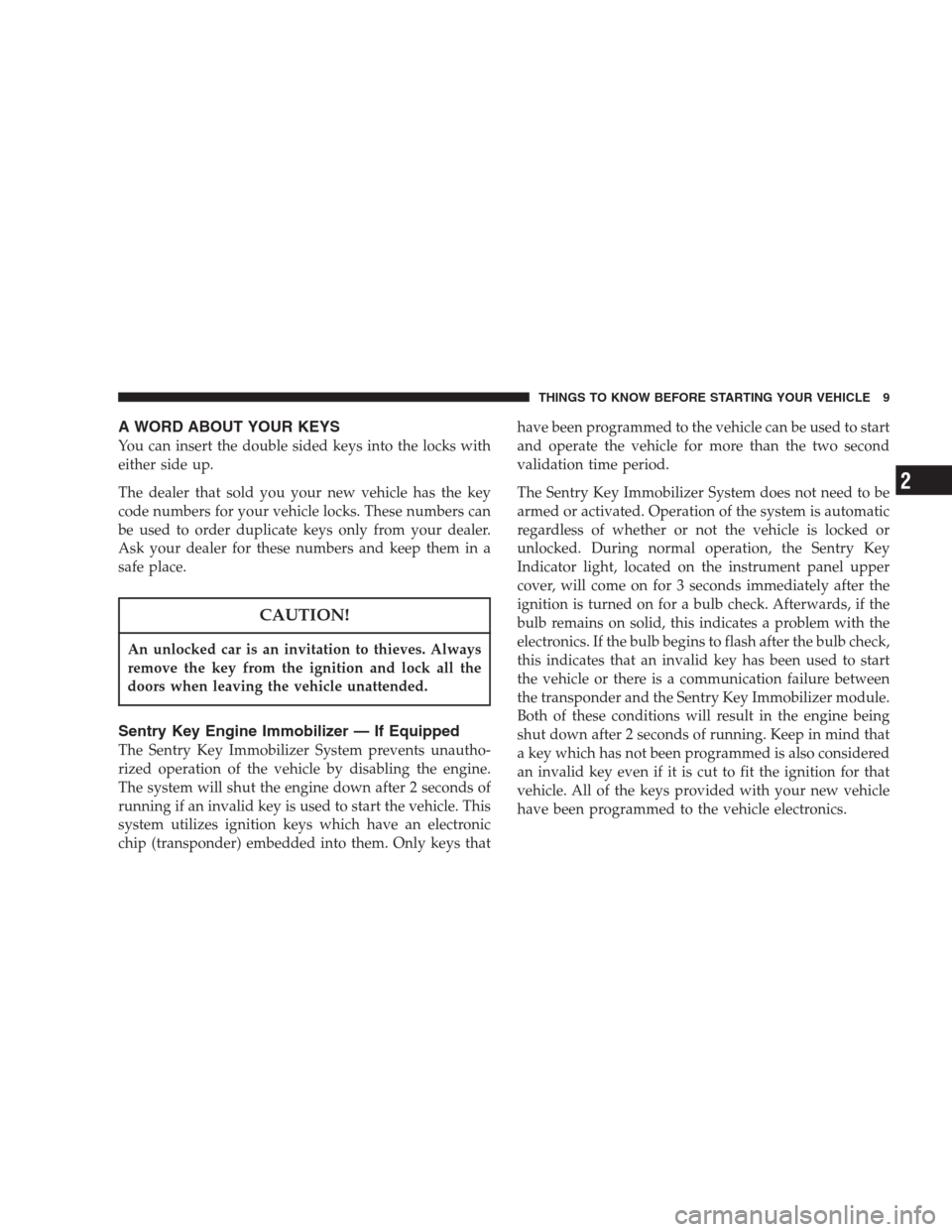
A WORD ABOUT YOUR KEYS
You can insert the double sided keys into the locks with
either side up.
The dealer that sold you your new vehicle has the key
code numbers for your vehicle locks. These numbers can
be used to order duplicate keys only from your dealer.
Ask your dealer for these numbers and keep them in a
safe place.
CAUTION!
An unlocked car is an invitation to thieves. Always
remove the key from the ignition and lock all the
doors when leaving the vehicle unattended.
Sentry Key Engine Immobilizer — If Equipped
The Sentry Key Immobilizer System prevents unautho-
rized operation of the vehicle by disabling the engine.
The system will shut the engine down after 2 seconds of
running if an invalid key is used to start the vehicle. This
system utilizes ignition keys which have an electronic
chip (transponder) embedded into them. Only keys thathave been programmed to the vehicle can be used to start
and operate the vehicle for more than the two second
validation time period.
The Sentry Key Immobilizer System does not need to be
armed or activated. Operation of the system is automatic
regardless of whether or not the vehicle is locked or
unlocked. During normal operation, the Sentry Key
Indicator light, located on the instrument panel upper
cover, will come on for 3 seconds immediately after the
ignition is turned on for a bulb check. Afterwards, if the
bulb remains on solid, this indicates a problem with the
electronics. If the bulb begins to flash after the bulb check,
this indicates that an invalid key has been used to start
the vehicle or there is a communication failure between
the transponder and the Sentry Key Immobilizer module.
Both of these conditions will result in the engine being
shut down after 2 seconds of running. Keep in mind that
a key which has not been programmed is also considered
an invalid key even if it is cut to fit the ignition for that
vehicle. All of the keys provided with your new vehicle
have been programmed to the vehicle electronics.
THINGS TO KNOW BEFORE STARTING YOUR VEHICLE 9
2
Page 49 of 273
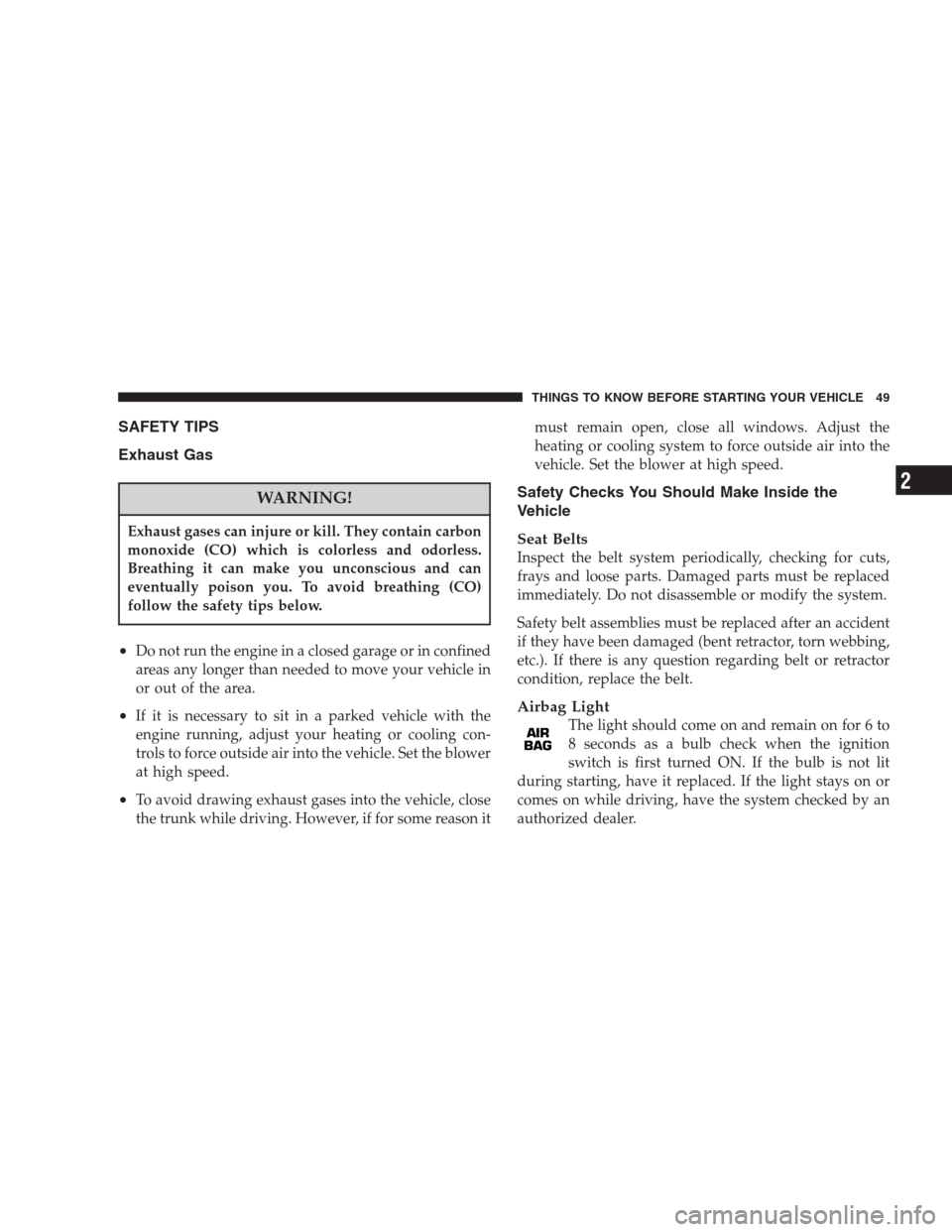
SAFETY TIPS
Exhaust Gas
WARNING!
Exhaust gases can injure or kill. They contain carbon
monoxide (CO) which is colorless and odorless.
Breathing it can make you unconscious and can
eventually poison you. To avoid breathing (CO)
follow the safety tips below.
•Do not run the engine in a closed garage or in confined
areas any longer than needed to move your vehicle in
or out of the area.
•If it is necessary to sit in a parked vehicle with the
engine running, adjust your heating or cooling con-
trols to force outside air into the vehicle. Set the blower
at high speed.
•To avoid drawing exhaust gases into the vehicle, close
the trunk while driving. However, if for some reason itmust remain open, close all windows. Adjust the
heating or cooling system to force outside air into the
vehicle. Set the blower at high speed.
Safety Checks You Should Make Inside the
Vehicle
Seat Belts
Inspect the belt system periodically, checking for cuts,
frays and loose parts. Damaged parts must be replaced
immediately. Do not disassemble or modify the system.
Safety belt assemblies must be replaced after an accident
if they have been damaged (bent retractor, torn webbing,
etc.). If there is any question regarding belt or retractor
condition, replace the belt.
Airbag Light
The light should come on and remain on for 6 to
8 seconds as a bulb check when the ignition
switch is first turned ON. If the bulb is not lit
during starting, have it replaced. If the light stays on or
comes on while driving, have the system checked by an
authorized dealer.
THINGS TO KNOW BEFORE STARTING YOUR VEHICLE 49
2
Page 109 of 273
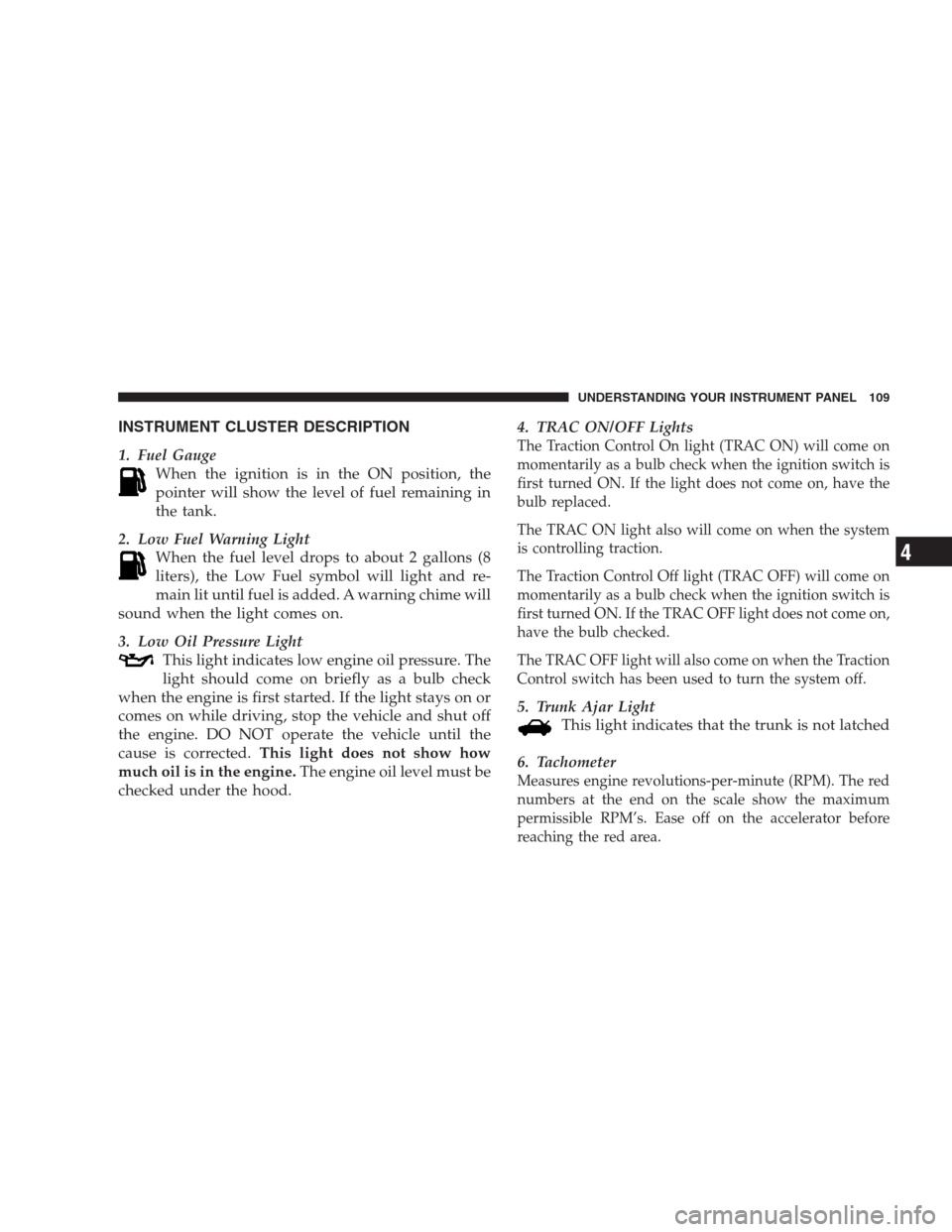
INSTRUMENT CLUSTER DESCRIPTION
1. Fuel Gauge
When the ignition is in the ON position, the
pointer will show the level of fuel remaining in
the tank.
2. Low Fuel Warning Light
When the fuel level drops to about 2 gallons (8
liters), the Low Fuel symbol will light and re-
main lit until fuel is added. A warning chime will
sound when the light comes on.
3. Low Oil Pressure Light
This light indicates low engine oil pressure. The
light should come on briefly as a bulb check
when the engine is first started. If the light stays on or
comes on while driving, stop the vehicle and shut off
the engine. DO NOT operate the vehicle until the
cause is corrected.This light does not show how
much oil is in the engine.The engine oil level must be
checked under the hood.4. TRAC ON/OFF Lights
The Traction Control On light (TRAC ON) will come on
momentarily as a bulb check when the ignition switch is
first turned ON. If the light does not come on, have the
bulb replaced.
The TRAC ON light also will come on when the system
is controlling traction.
The Traction Control Off light (TRAC OFF) will come on
momentarily as a bulb check when the ignition switch is
first turned ON. If the TRAC OFF light does not come on,
have the bulb checked.
The TRAC OFF light will also come on when the Traction
Control switch has been used to turn the system off.
5. Trunk Ajar Light
This light indicates that the trunk is not latched
6. Tachometer
Measures engine revolutions-per-minute (RPM). The red
numbers at the end on the scale show the maximum
permissible RPM’s. Ease off on the accelerator before
reaching the red area.
UNDERSTANDING YOUR INSTRUMENT PANEL 109
4
Page 111 of 273
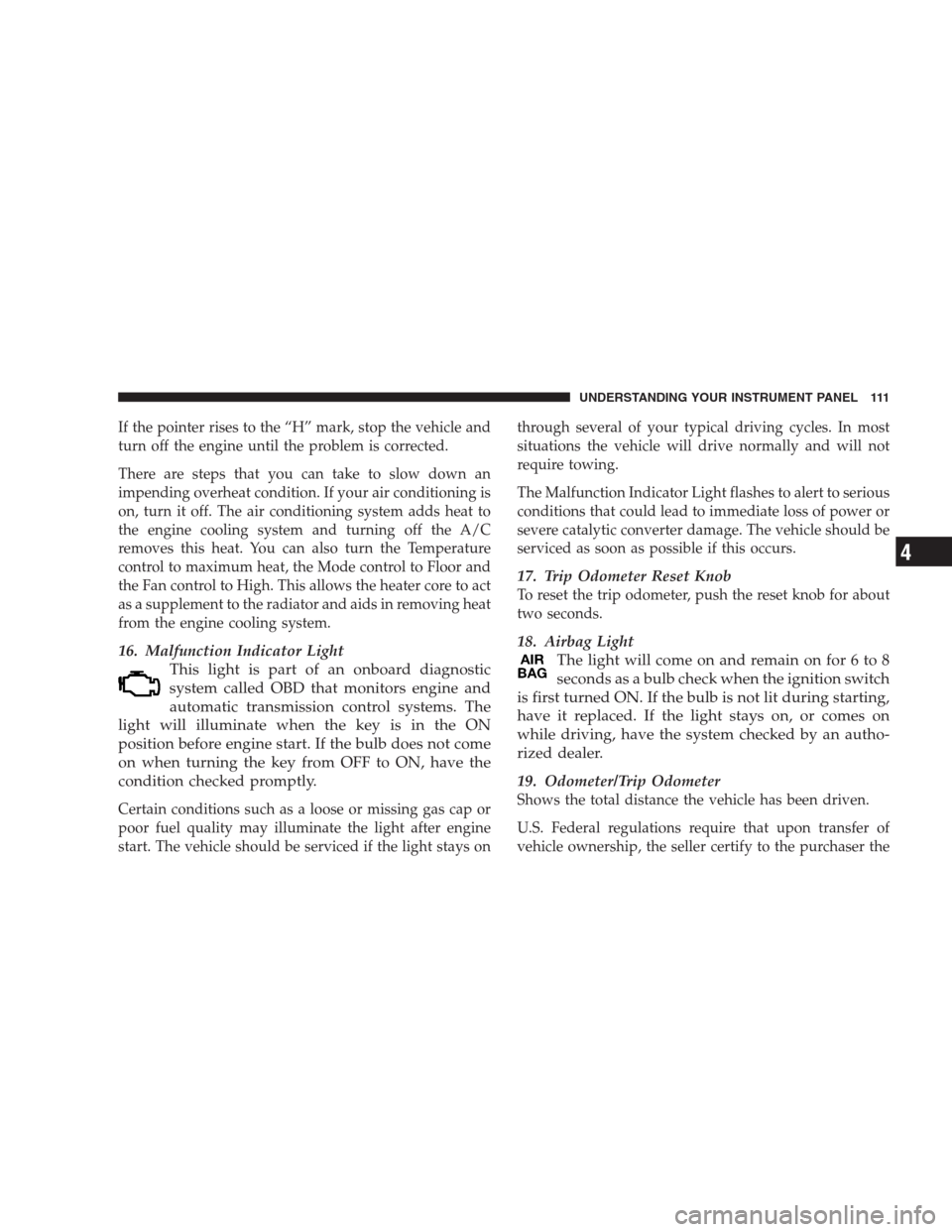
If the pointer rises to the “H” mark, stop the vehicle and
turn off the engine until the problem is corrected.
There are steps that you can take to slow down an
impending overheat condition. If your air conditioning is
on, turn it off. The air conditioning system adds heat to
the engine cooling system and turning off the A/C
removes this heat. You can also turn the Temperature
control to maximum heat, the Mode control to Floor and
the Fan control to High. This allows the heater core to act
as a supplement to the radiator and aids in removing heat
from the engine cooling system.
16. Malfunction Indicator Light
This light is part of an onboard diagnostic
system called OBD that monitors engine and
automatic transmission control systems. The
light will illuminate when the key is in the ON
position before engine start. If the bulb does not come
on when turning the key from OFF to ON, have the
condition checked promptly.
Certain conditions such as a loose or missing gas cap or
poor fuel quality may illuminate the light after engine
start. The vehicle should be serviced if the light stays onthrough several of your typical driving cycles. In most
situations the vehicle will drive normally and will not
require towing.
The Malfunction Indicator Light flashes to alert to serious
conditions that could lead to immediate loss of power or
severe catalytic converter damage. The vehicle should be
serviced as soon as possible if this occurs.
17. Trip Odometer Reset Knob
To reset the trip odometer, push the reset knob for about
two seconds.
18. Airbag Light
The light will come on and remain on for 6 to 8
seconds as a bulb check when the ignition switch
is first turned ON. If the bulb is not lit during starting,
have it replaced. If the light stays on, or comes on
while driving, have the system checked by an autho-
rized dealer.
19. Odometer/Trip Odometer
Shows the total distance the vehicle has been driven.
U.S. Federal regulations require that upon transfer of
vehicle ownership, the seller certify to the purchaser the
UNDERSTANDING YOUR INSTRUMENT PANEL 111
4
Page 139 of 273
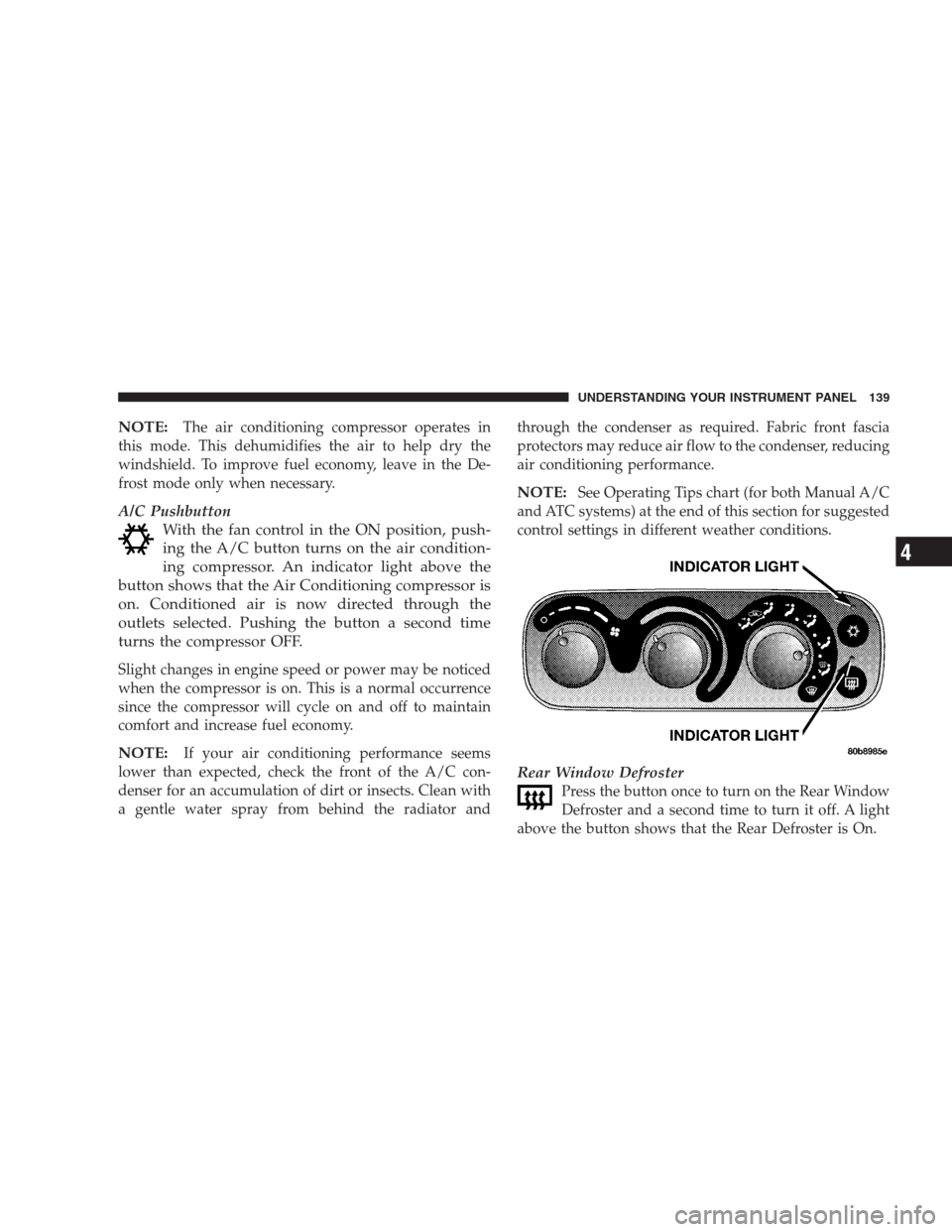
NOTE:The air conditioning compressor operates in
this mode. This dehumidifies the air to help dry the
windshield. To improve fuel economy, leave in the De-
frost mode only when necessary.
A/C Pushbutton
With the fan control in the ON position, push-
ing the A/C button turns on the air condition-
ing compressor. An indicator light above the
button shows that the Air Conditioning compressor is
on. Conditioned air is now directed through the
outlets selected. Pushing the button a second time
turns the compressor OFF.
Slight changes in engine speed or power may be noticed
when the compressor is on. This is a normal occurrence
since the compressor will cycle on and off to maintain
comfort and increase fuel economy.
NOTE:If your air conditioning performance seems
lower than expected, check the front of the A/C con-
denser for an accumulation of dirt or insects. Clean with
a gentle water spray from behind the radiator andthrough the condenser as required. Fabric front fascia
protectors may reduce air flow to the condenser, reducing
air conditioning performance.
NOTE:See Operating Tips chart (for both Manual A/C
and ATC systems) at the end of this section for suggested
control settings in different weather conditions.
Rear Window Defroster
Press the button once to turn on the Rear Window
Defroster and a second time to turn it off. A light
above the button shows that the Rear Defroster is On.
UNDERSTANDING YOUR INSTRUMENT PANEL 139
4
Page 173 of 273
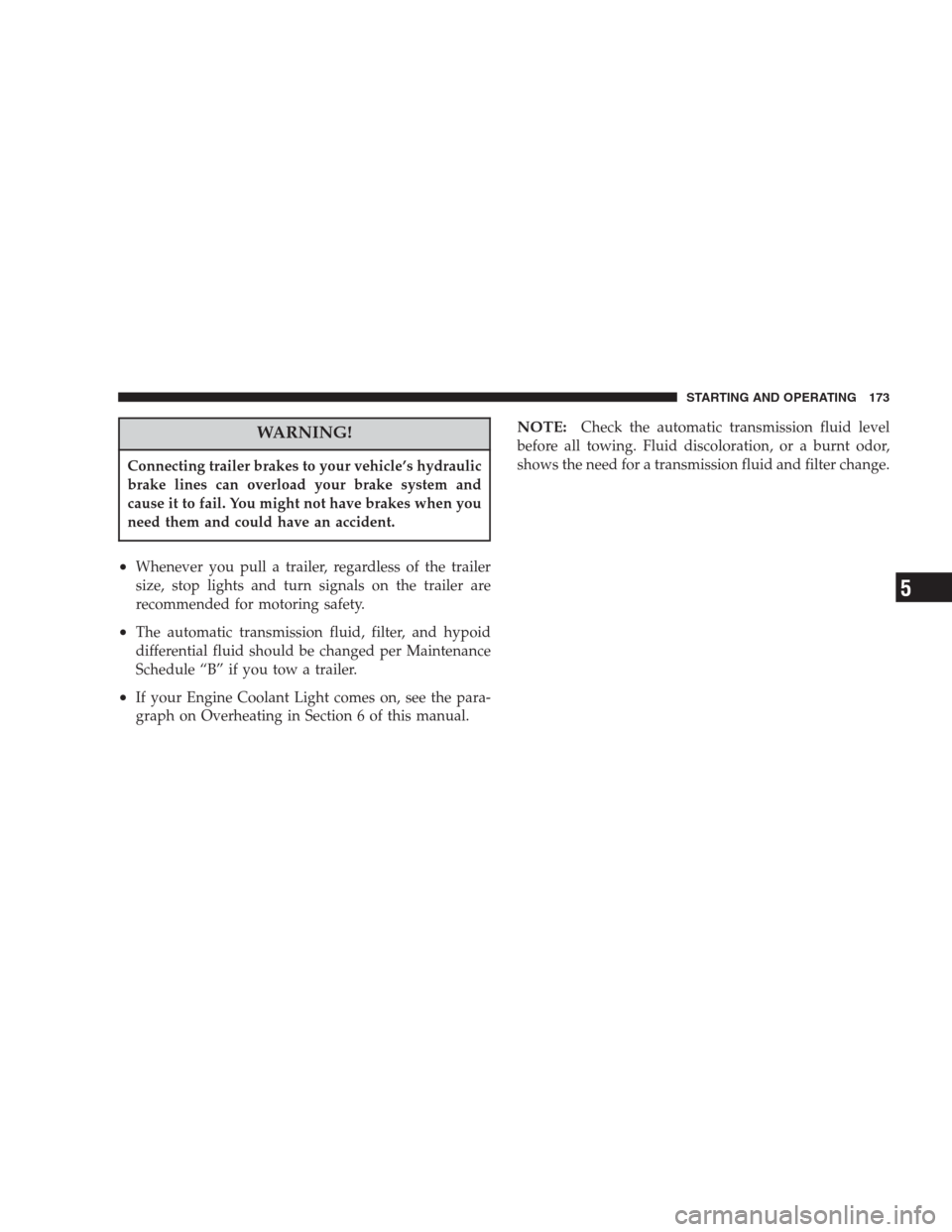
WARNING!
Connecting trailer brakes to your vehicle’s hydraulic
brake lines can overload your brake system and
cause it to fail. You might not have brakes when you
need them and could have an accident.
•Whenever you pull a trailer, regardless of the trailer
size, stop lights and turn signals on the trailer are
recommended for motoring safety.
•The automatic transmission fluid, filter, and hypoid
differential fluid should be changed per Maintenance
Schedule “B” if you tow a trailer.
•If your Engine Coolant Light comes on, see the para-
graph on Overheating in Section 6 of this manual.
NOTE:Check the automatic transmission fluid level
before all towing. Fluid discoloration, or a burnt odor,
shows the need for a transmission fluid and filter change.
STARTING AND OPERATING 173
5
Page 184 of 273
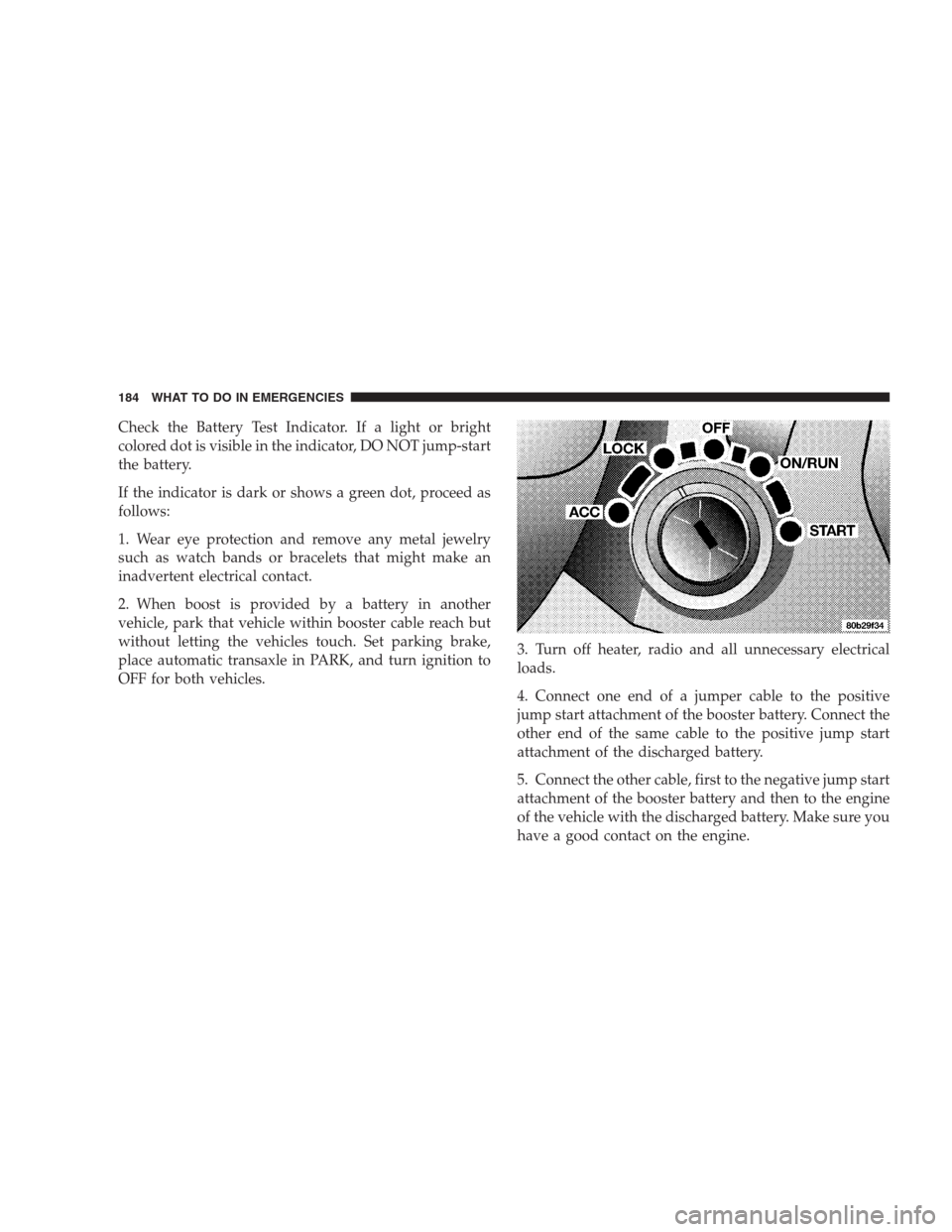
Check the Battery Test Indicator. If a light or bright
colored dot is visible in the indicator, DO NOT jump-start
the battery.
If the indicator is dark or shows a green dot, proceed as
follows:
1. Wear eye protection and remove any metal jewelry
such as watch bands or bracelets that might make an
inadvertent electrical contact.
2. When boost is provided by a battery in another
vehicle, park that vehicle within booster cable reach but
without letting the vehicles touch. Set parking brake,
place automatic transaxle in PARK, and turn ignition to
OFF for both vehicles.3. Turn off heater, radio and all unnecessary electrical
loads.
4. Connect one end of a jumper cable to the positive
jump start attachment of the booster battery. Connect the
other end of the same cable to the positive jump start
attachment of the discharged battery.
5. Connect the other cable, first to the negative jump start
attachment of the booster battery and then to the engine
of the vehicle with the discharged battery. Make sure you
have a good contact on the engine.
184 WHAT TO DO IN EMERGENCIES
Page 238 of 273
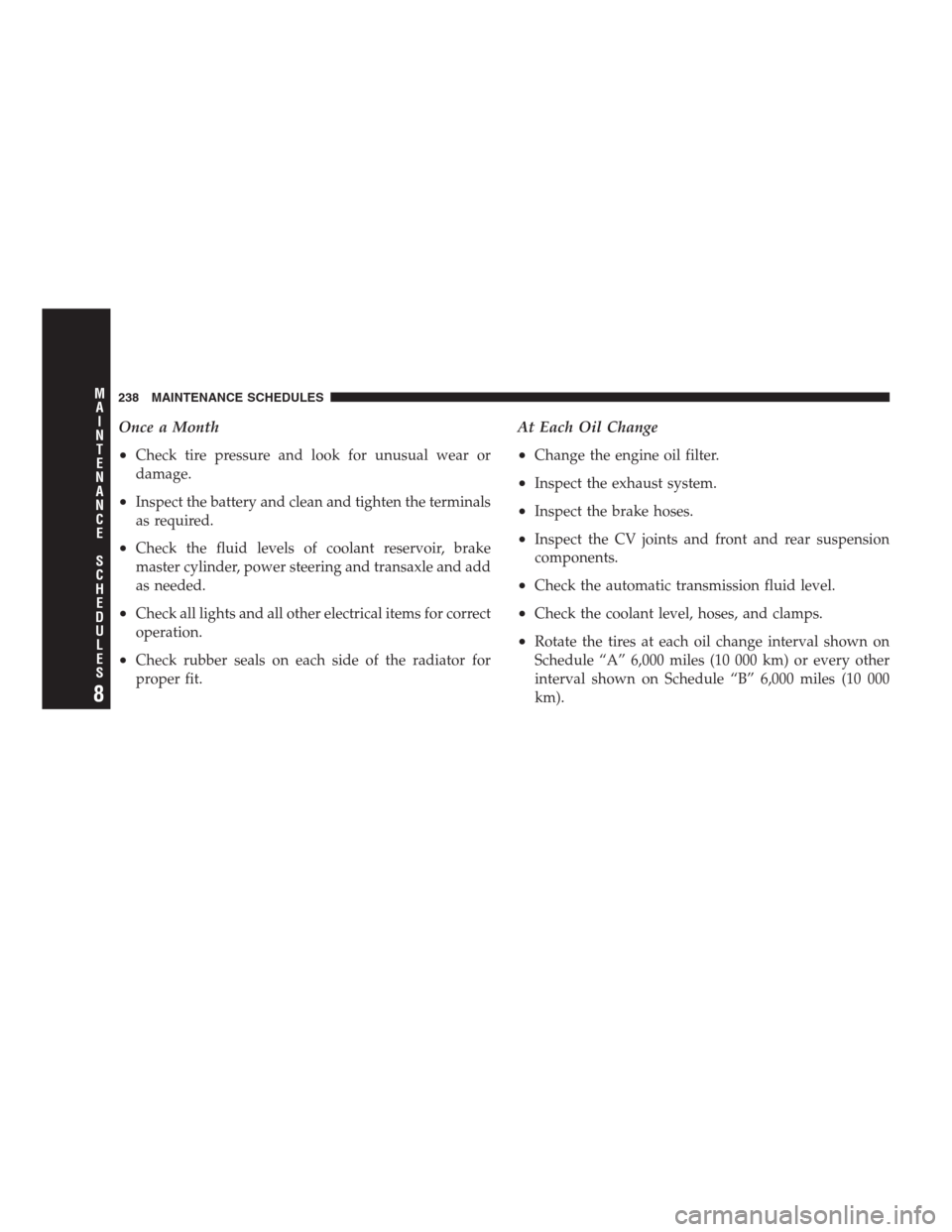
Once a Month
•
Check tire pressure and look for unusual wear or
damage.
•Inspect the battery and clean and tighten the terminals
as required.
•Check the fluid levels of coolant reservoir, brake
master cylinder, power steering and transaxle and add
as needed.
•Check all lights and all other electrical items for correct
operation.
•Check rubber seals on each side of the radiator for
proper fit.
At Each Oil Change
•
Change the engine oil filter.
•Inspect the exhaust system.
•Inspect the brake hoses.
•Inspect the CV joints and front and rear suspension
components.
•Check the automatic transmission fluid level.
•Check the coolant level, hoses, and clamps.
•Rotate the tires at each oil change interval shown on
Schedule “A” 6,000 miles (10 000 km) or every other
interval shown on Schedule “B” 6,000 miles (10 000
km).
238 MAINTENANCE SCHEDULES
8
M
A
I
N
T
E
N
A
N
C
E
S
C
H
E
D
U
L
E
S
Page 262 of 273
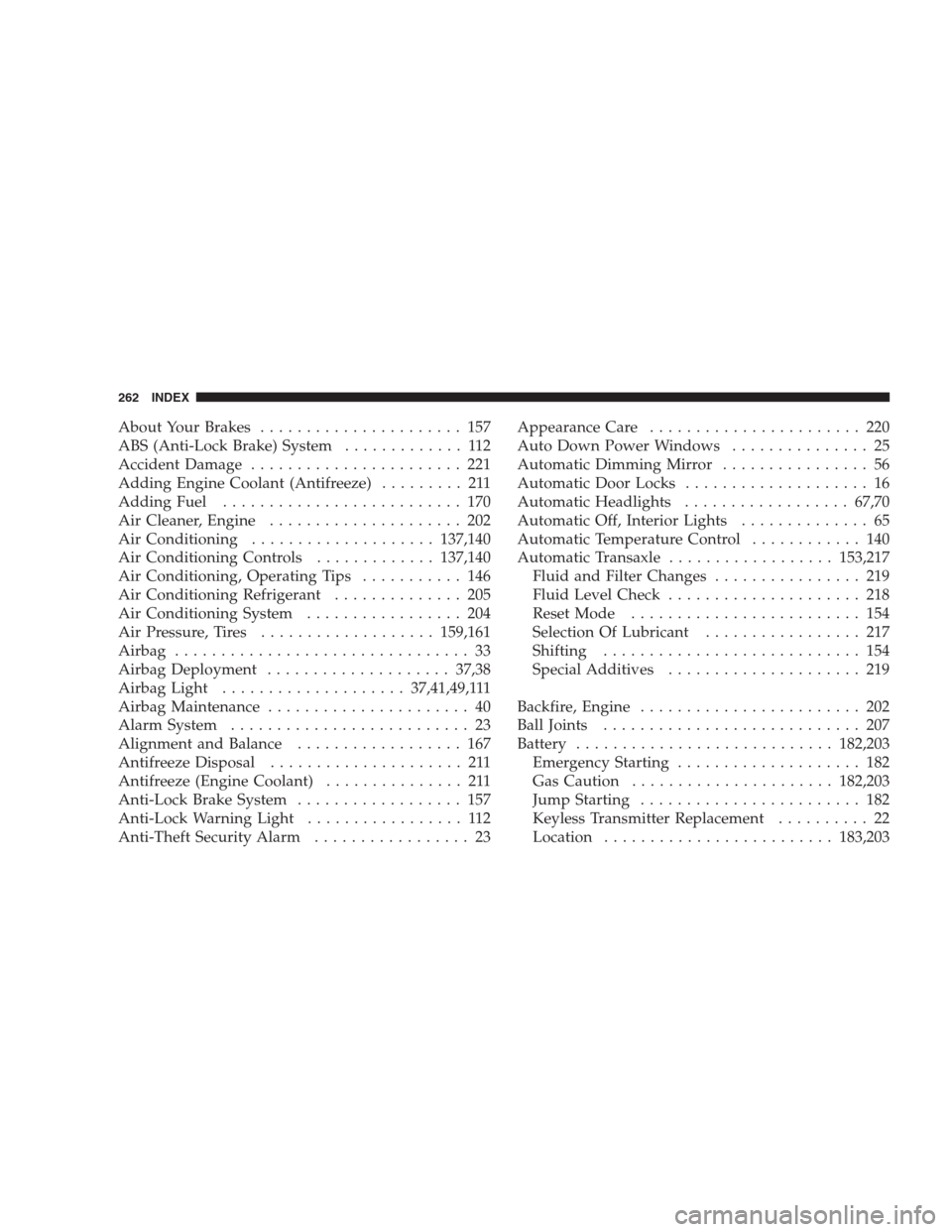
About Your Brakes...................... 157
ABS (Anti-Lock Brake) System............. 112
Accident Damage....................... 221
Adding Engine Coolant (Antifreeze)......... 211
Adding Fuel.......................... 170
Air Cleaner, Engine..................... 202
Air Conditioning....................137,140
Air Conditioning Controls.............137,140
Air Conditioning, Operating Tips........... 146
Air Conditioning Refrigerant.............. 205
Air Conditioning System................. 204
Air Pressure, Tires...................159,161
Airbag................................ 33
Airbag Deployment....................37,38
Airbag Light....................37,41,49,111
Airbag Maintenance...................... 40
Alarm System.......................... 23
Alignment and Balance.................. 167
Antifreeze Disposal..................... 211
Antifreeze (Engine Coolant)............... 211
Anti-Lock Brake System.................. 157
Anti-Lock Warning Light................. 112
Anti-Theft Security Alarm................. 23Appearance Care....................... 220
Auto Down Power Windows............... 25
Automatic Dimming Mirror................ 56
Automatic Door Locks.................... 16
Automatic Headlights..................67,70
Automatic Off, Interior Lights.............. 65
Automatic Temperature Control............ 140
Automatic Transaxle..................153,217
Fluid and Filter Changes................ 219
Fluid Level Check..................... 218
Reset Mode......................... 154
Selection Of Lubricant................. 217
Shifting............................ 154
Special Additives..................... 219
Backfire, Engine........................ 202
Ball Joints............................ 207
Battery............................182,203
Emergency Starting.................... 182
Gas Caution......................182,203
Jump Starting........................ 182
Keyless Transmitter Replacement.......... 22
Location.........................183,203
262 INDEX
Page 263 of 273
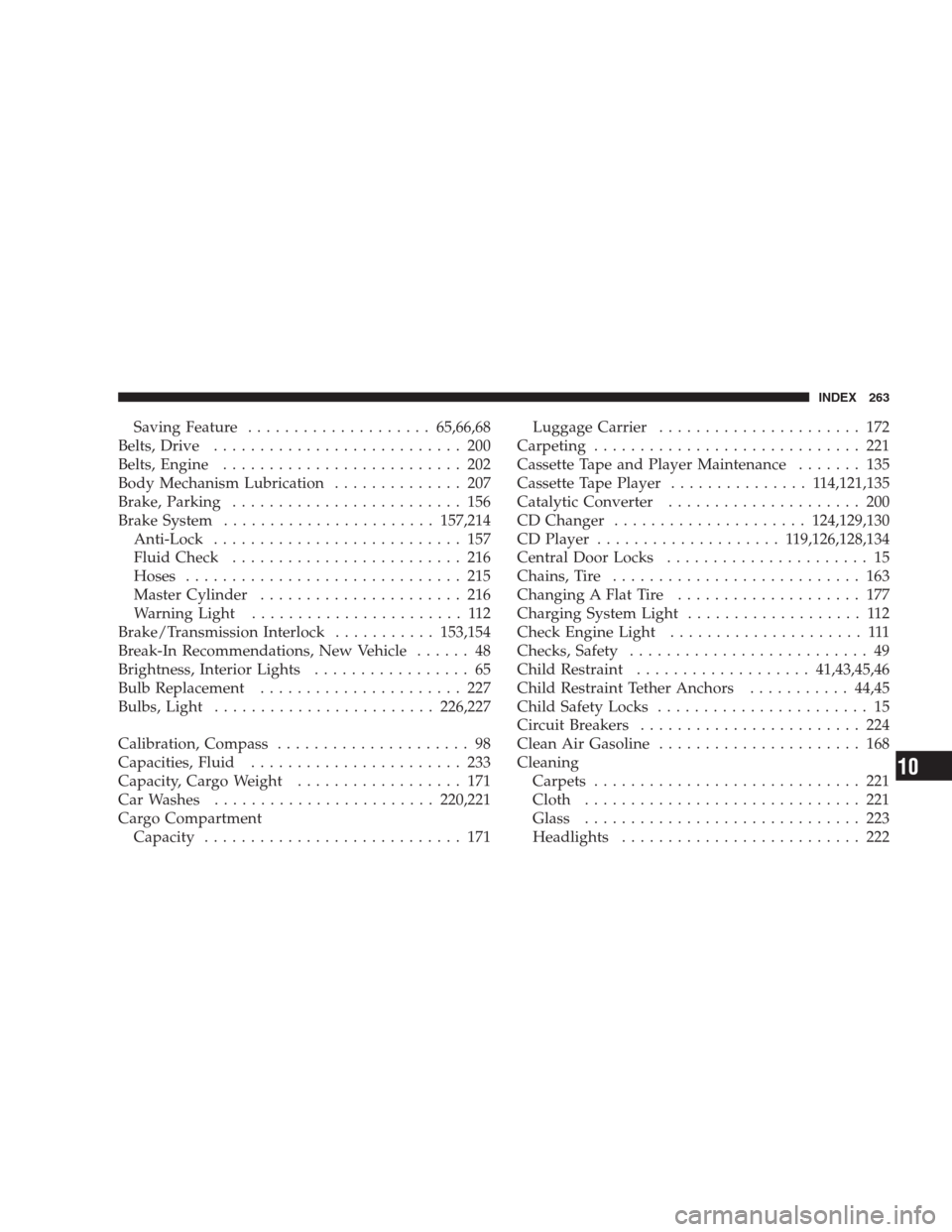
Saving Feature....................65,66,68
Belts, Drive........................... 200
Belts, Engine.......................... 202
Body Mechanism Lubrication.............. 207
Brake, Parking......................... 156
Brake System.......................157,214
Anti-Lock........................... 157
Fluid Check......................... 216
Hoses.............................. 215
Master Cylinder...................... 216
Warning Light....................... 112
Brake/Transmission Interlock...........153,154
Break-In Recommendations, New Vehicle...... 48
Brightness, Interior Lights................. 65
Bulb Replacement...................... 227
Bulbs, Light........................226,227
Calibration, Compass..................... 98
Capacities, Fluid....................... 233
Capacity, Cargo Weight.................. 171
Car Washes........................220,221
Cargo Compartment
Capacity............................ 171Luggage Carrier...................... 172
Carpeting............................. 221
Cassette Tape and Player Maintenance....... 135
Cassette Tape Player............... 114,121,135
Catalytic Converter..................... 200
CD Changer.....................124,129,130
CD Player.................... 119,126,128,134
Central Door Locks...................... 15
Chains, Tire........................... 163
Changing A Flat Tire.................... 177
Charging System Light................... 112
Check Engine Light..................... 111
Checks, Safety.......................... 49
Child Restraint...................41,43,45,46
Child Restraint Tether Anchors...........44,45
Child Safety Locks....................... 15
Circuit Breakers........................ 224
Clean Air Gasoline...................... 168
Cleaning
Carpets............................. 221
Cloth.............................. 221
Glass.............................. 223
Headlights.......................... 222
INDEX 263
10